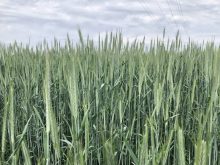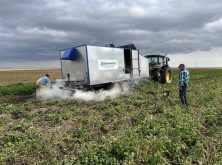Given this year’s cool, wet spring, harvesting in a timely fashion might become a challenge. In pulse crops, desiccant use can be a critical component of harvest management to dry down any remaining green material in the field as well as deal with actively growing weeds.
Dale Risula, Saskatchewan’s provincial special crops specialist, starts almost every conversation with the same comment: “Desiccants are not designed to speed up crop maturity.”
“Desiccants are harvest management tools that facilitate the timely harvest of crops, like pulse crops, that mature unevenly because of their indeterminate growth habit,” explains Risula. “Desiccants are widely used around the world for that purpose.”
Read Also

Claas brings 1000 Series SP forage harvesters to Canada
In mid-August, Claas unveiled its new line of Jaguar forage harvesters at an event in Visalia, California, deep in the heart of that state’s dairy region.
True desiccants are not systemic — they don’t move within the plant. Instead, they act on contact with living material and destroy green tissue quickly. “The desiccant acts by breaking down plant cell walls — releasing their contents — and that causes the material to dry down very quickly,” says Risula. “There are other systemic products like glyphosate that are desiccant-like. They are translocated within the plant and will eventually kill the plant. They don’t typically work as quickly as a contact desiccant.”
- More Grainews: How to harvest pulse crops
When and how to apply a desiccant
“Bearing in mind desiccants will not speed up maturity, application needs to be timed to about 30 per cent moisture or less,” says Risula. “This is a general guideline and farmers should check the label of the product they are going to use for specific instructions.”
In pulses, the bottom pods mature first. As the plant continues to grow and flower, the pods towards the top of the plant may not mature enough to harvest, but growers will usually get the majority of the pods harvested.
The herbicide label will have detailed instructions on when to apply and the rates of application. It is very important, particularly in pulses, to follow label recommendations because of the risk of residues after harvest.
“Because desiccants are applied very close to harvest, there is always the risk of residues on the seed,” says Risula. “Pulses are exported for the most part and importing countries have strict limits on maximum residue limits, or MRLs. If the residues exceed the limit, the crop will be downgraded and can be almost worthless. Additionally, Canada’s reputation as an exporter could be tarnished.” Risula and the provincial pulse organizations strongly recommended farmers talk with their pulse processor or buyer to understand what MRLs will apply to their crop before they use a desiccant.
Risula advises farmers to use the provincial crop protection guides, which explains application timing and rates on for registered products. It’s also important for growers to check the labels for rates on the over 20 brand names containing glyphosate as an active ingredient.















